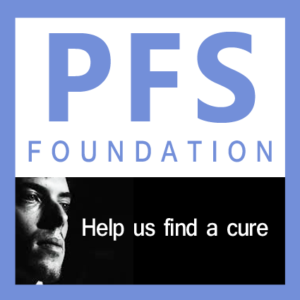Please note that the PFS Foundation is not a medical organization and, as such, does not offer medical advice. No doctor-patient relationship is implicit or implied. Rather, these Frequently Asked Questions are meant as a starting point for ongoing discussions among patients, doctors and researchers.
Q1: What is post-finasteride syndrome?
PFS, which is listed in the National Institutes of Health’s Genetic and Rare Diseases Information Center, and in the database of the National Organization for Rare Disorders, describes persistent and serious side effects that continue long after the drug has been discontinued. They include sexual, neurological, physical and psychological adverse reactions in patients who’ve taken finasteride, a 5-alpha-reductase type II enzyme inhibitor used to treat hair loss (Propecia, finasteride 1 mg) or enlarged prostate (Proscar, finasteride 5 mg). Reported symptoms include loss of libido, erectile dysfunction, depression, suicidal ideation, anxiety, panic attacks, Peyronie’s disease, penile shrinkage, chronic testicular pain, gynecomastia, muscle atrophy, cognitive impairment, insomnia and dry skin. (For a complete list of reported PFS symptoms, see our About Post-Finasteride Syndrome page. For diagnostic criteria of the condition, see our PFS Diagnostic Criteria page.)
Q2: How many men who take finasteride get PFS?
What’s certain is that a subset of men who take finasteride develop PFS. According to a 2017 study published in PeerJ and titled Persistent erectile dysfunction in men exposed to the 5α-reductase inhibitors finasteride or dutasteride, 1.2% of young men (defined as those 16 to 42 years old) who took finasteride for 206 days or longer, and had no prior history of sexual dysfunction, developed persistent erectile dysfunction (PED) that lasted an average of 4.2 years after quitting the drug. (It is not known if PED in that subset ever subsided, or persisted.) The study also showed that the longer men are on finasteride, the more likely they are to develop PED. Overall, men who take finasteride for at least 205 days are nearly five times more likely to develop PED than men who take it for less than 205 days. For symptoms other than PED, no similar statistical analyses involving critical masses of patient records have yet been published. Still, anyone interested in absolute numbers of reported PFS symptoms should review the World Health Organization’s VigiBase database of adverse drug reactions (ADRs), which currently contains more than 18,000 finasteride ADRs. Among those are more than 6,100 reproductive disorders, 4,100 psychiatric disorders, 3,400 nervous system disorders and 3,100 skin disorders.
Q3: Why do some finasteride patients develop PFS while others never seem to have any problems with the drug?
A: That’s a key question in the PFS riddle. Unfortunately, medical science has yet to determine which factors, genetic or otherwise, make patients disposed to developing the condition. But we hope that in the coming years, clinical research will demonstrate precisely that. Meanwhile, judging by the more than 3,000 PFS patients who have contacted the PFS Foundation since 2012, it appears that men in their late teens, 20s and 30s are most susceptible to the condition.
Q4: Is there any way to know if I’m susceptible to PFS?
A: At the moment, there’s no known test for determining whether any finasteride patient will develop PFS. However, the PFS Foundation strongly discourages the use of finasteride for hair loss by anyone. The same goes for all clinicians. We discourage the prescribing of finasteride for hair loss by any physician. We strongly believe that the risks of finasteride overwhelmingly outweigh its benefits (i.e. on average a 10% increase in hair count over balding areas).
Q5: Is there any cure, or at least treatment, for PFS?
Unfortunately, PFS is a condition with no known cure at this time, and few, if any, effective treatments.
Q6: How long before an effective treatment for PFS is developed?
No one knows for sure. But the PFS Foundation is working as fast as possible to facilitate research that promises to identify the underlying biological mechanisms of PFS while laying the groundwork for the identification or development of effective therapies. Simultaneously, we monitor FDA trials for potentially promising products in clinical development. Those developments are housed on our Research Initiatives page.
Q7: Are there any cases of PFS patients who’ve gotten 100% better?
There are no known scientific reports of PFS patients returning to full health. But a handful of PFS patients have reported to us that they’ve felt 80%, 90% or even 99% better over a period of one to five years. Other patients report that they become more stable and learn to better cope with the condition over a period of one to three years, rather than return to full health. Unfortunately, a small minority of patients report increasing severity of symptoms over time, especially with respect to some of the psychological side effects.
Q8: I can’t find a doctor in my area who’s familiar with PFS. Can you recommend one?
A: In the Resources section of the PFS Foundation website, we have a page called Medical Professionals. Listed there are more than 80 doctors, psychologists and pharmacologists who counsel PFS patients and their family members. Feel free to reach out to any of them with questions you might have, including appointment requests. (Needless to say, those professionals don’t cover the entire world, which is why we’re always looking for more. If you’d like to suggest adding one, please email patient manager Philip Roberts at proberts@pfsfoundation.org.)
Q9: After describing my PFS symptoms to my doctor, he/she said he/she’d never heard of the condition. Then he/she implied that it’s probably all in my head. What can I do?
A: Unfortunately, PFS is still not known or recognized by the large majority of all medical professionals, and many doctors cruelly stigmatize patients. If you come across such a doctor and are depending on him/her to treat your PFS, you would probably benefit from finding a doctor who is more knowledgeable about the condition. One of the PFS Foundation’s chief goals is to achieve universal awareness and acceptance of PFS as a bona fide and serious medical condition. In the meantime, we are working hard to publish as much medical literature and other news about the condition as possible on our website. If PFS patients and/or family members encounter resistance to and dismissal of PFS as a real medical condition by their doctor, but their doctor is at least open-minded, we recommend that they ask him/her to carefully review this literature and news, along with our PFS Diagnostic Criteria, Doctors & Researchers Speaking Out, PFS Quilt and Propecia Litigation Library pages. More and more, doctors who do so wind up contacting the foundation directly to inquire further about the condition.
Q10: When I sought treatment for PFS from my doctor, all he did was prescribe antidepressants. Is that the proper course of action? Are antidepressants safe for PFS patients?
The aforementioned 2017 study published in PeerJ (Persistent erectile dysfunction in men exposed to the 5α-reductase inhibitors finasteride or dutasteride) also found that the use of selective serotonin reuptake inhibitors (SSRIs) were a risk factor for developing PED with the use of finasteride for hair loss. However, there have been no published medical studies that report on the effectiveness of SSRIs to treat PFS. Therefore, we recommend caution and discussion with your physician about the potential risks before deciding to treat it with SSRIs. Unfortunately, there have also been no published medical studies that report on the effectiveness of other antidepressants in the treatment of depression associated with PFS. The depression of PFS can be very debilitating and finding effective treatments for the depression of PFS can be challenging and require considerable trial and error in consultation with your doctor. Separately, Sage Therapeutics has allopregnanolone and allopregnanolone analogue products that are currently in trials for various indications, including major depressive disorder and insomnia.
Q11: I’d like to get in touch with other PFS patients in my area, or anywhere in the world, for that matter. Can you help me?
A: The PFS Foundation has a Patient Support program that does precisely that. Anyone wishing to connect with other PFS patients and/or their family members should download our Patient Support form, complete it and email it back to us at social@pfsfoundation.org. The program can also connect the loved ones of PFS patients who have taken their own lives with the loved ones of other PFS patients who suffered the same fate.
Q12: I currently take finasteride but don’t have any PFS symptoms. As a precautionary measure, however, I want to quit the drug. If I do, could I develop PFS after stopping?
This is a difficult question to answer as there is a small minority of PFS patients who have reported anecdotally that they have developed PFS only after quitting finasteride. Other PFS patients anecdotally report PFS symptoms while using finasteride that get worse after quitting the drug. However, the 2017 PeerJ study (Persistent erectile dysfunction in men exposed to the 5α-reductase inhibitors finasteride or dutasteride) conclusively determined that the risk of developing PFS increases with increased duration of use. We just don’t have enough knowledge yet to know which risk is greater, but we know for sure that the risk of developing PFS increases with increased duration of drug use.
Q13: I understand we don’t know which is riskier, quitting finasteride or staying on it, but I still want to quit. Should I stop taking the drug cold turkey, or gradually taper off it?
There is evidence indicating that the longer someone takes finasteride, the higher the risk of developing PFS. Additionally, although the drug is eliminated from the blood relatively quickly (half-life 4.8 to 6 hours), it remains active for much longer because it irreversibly binds to (and blocks the normal functioning of) the target enzyme 5-alpha-reductase (half-life 30 days). After finasteride is discontinued, the body must produce new 5-alpha-reductase molecules to replace the ones that were inactivated by the finasteride. In other words, the biological effects of finasteride ensure a relatively slow tapering of the “drug effect” over about 30 to 60 days, even if you stop the drug cold turkey. All these factors would indicate that tapering off finasteride offers no advantage compared to abruptly stopping the drug. On the other hand, there are reports of people developing PFS within a few days of stopping finasteride. This would suggest that tapering might be a safer approach. The bottom line is that no one knows if tapering off is safer than abruptly discontinuing the drug. Anecdotally, many PFS patients report that their sexual symptoms gradually increase in severity over time while taking finasteride.
Q14: Can dutasteride also cause PFS?
A: Yes. Like finasteride, dutasteride (brand name Adovart) is a 5-alpha-reductase inhibitor that has a similar chemical composition. We have received many reports of PFS-like symptoms from dutasteride patients. Additionally, the World Health Organization’s VigiBase database of adverse reactions to dutasteride paints an epidemiological profile similar to that of finasteride.
Q15: Can saw palmetto also cause PFS?
A: According to the Finasteride Drug Summary in Prescriber’s Digital Reference:
Saw palmetto may inhibit 5 alpha-reductase, preventing the conversion of testosterone to dihydrotestosterone. This action is similar to the action of 5-alpha reductase inhibitors, such as dutasteride and finasteride. Co-use is likely to be common by patients, but the effects of co-use are not known. In theory, the effects could be additive, but it is not known if the added effects would be beneficial or harmful. Clinicians should be alert for any unusual effects if patients ingest saw palmetto supplements while taking 5-alpha reductase inhibitors.
Additionally, the PFS Foundation has been contacted by at least 30 patients who took saw palmetto only, as a hair-loss treatment, and developed symptoms strikingly similar to those experienced by PFS patients.
Q16: I know there are currently no effective treatments for PFS, but can you recommend any special diet, exercise regimen, etc., that might help?
The PFS Foundation is not a medical organization and, as such, can’t offer health or medical advice. However, a number of PFS patients worldwide with whom we’re in regular contact have told us they’ve adopted certain habits that help them manage the condition. The best way to connect with these patients is to participate in our Patient Support program. When you send us your Patient Support form, include a note in your email letting us know you’d specifically like to connect with fellow PFS patients who are willing to share their coping strategies. Some of the doctors listed on our Medical Professionals page may also recommend such strategies.
Q17: Can finasteride have an impact on male fertility?
A: Finasteride, even at low doses, may cause reduced sperm counts, sperm concentration and sperm motility that can result in male infertility in some men. These abnormal sperm parameters improve dramatically after quitting finasteride. In most, but not all, of these men, these sperm parameters will return to normal after quitting the drug. That, according to 2013 study published in the American Society for Reproductive Medicine’s Fertility and Sterility journal, titled Finasteride use in the male infertility population: effects on semen and hormone parameters.
Q18: Can topical finasteride cause PFS in the same way that oral finasteride does in some men?
A: Most likely, yes. In 2013, Swiss pharmaceutical company Polichem SA conducted a study, published in the Journal of the American Academy of Dermatology and titled Single and repeated dose of finasteride topical solution in subjects with androgenetic alopecia, which showed that topical finasteride is absorbed and lowers serum DHT levels almost to the same degree as the oral medication. Furthermore, we have reports from many patients who used topical finasteride solutions only and still developed PFS symptoms. For more information, please read these two reports from our newsroom:
Study Used to Push Non-FDA-Approved Topical Finasteride Knocked by Top German Rx Journal
Topical Finasteride Could Precipitate PFS, Top German Rx Journal Warns
Q19: Can women get PFS?
A: Most likely, yes. We are in contact with many women around the world who’ve told us that, as a direct result of taking finasteride, they suffer from many of the same symptoms as male PFS patients. One such woman, Sara, was profiled in a 2016 documentary on the Belgian public TV, titled The Wonderhair Pill. (Her story begins around 16:10.)
Q20: I’m a PFS patient and I’d like to do my part for PFS research by participating in a clinical study on the condition. How can I do that?
A: None of the studies being sponsored by the PFS Foundation currently are actively recruiting patients. But future studies may involve patient testing. If so, we’ll reach out to our entire PFS patient population to let you know and to provide you with participation parameters. But if you’d like to “sign up” as a willing candidate ahead of time, please email proberts@pfsfoundation.org and we’ll note it in our database.
Additional PFS Foundation resource pages



